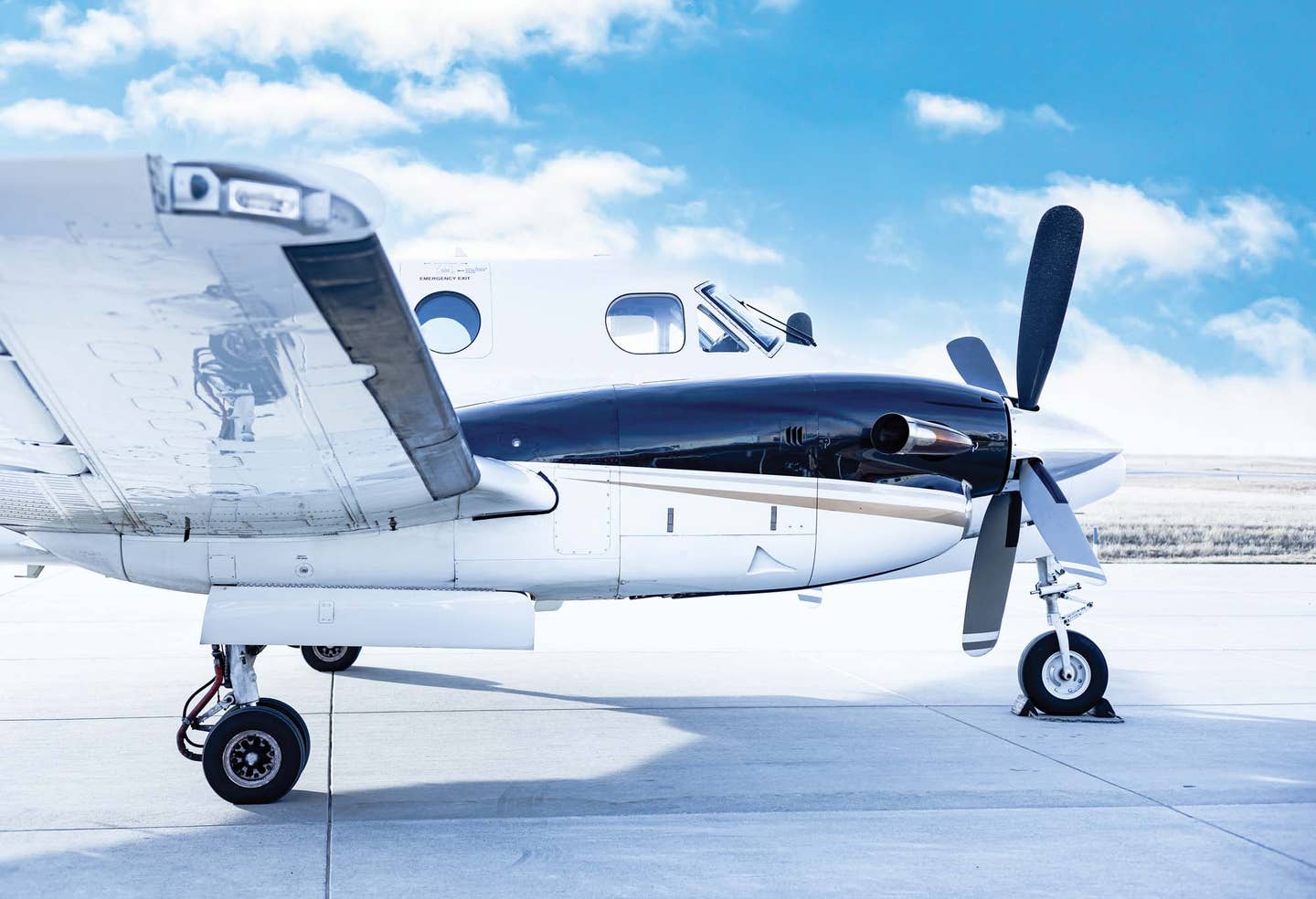In Love With The AT-6
Big and chunky looking, the surprisingly agile texan redefined the role of the advanced trainer
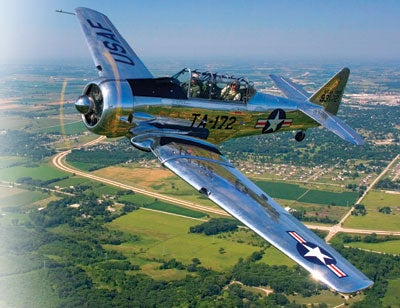 On the ground, a T-6 Texan looks anything but fun. The first time I flew a Texan, 20 years ago out of Santa Paula, Calif., with the late Doug Dullenkopf, I expected to have my hands full with a heavy, unwieldy beast.
On the ground, a T-6 Texan looks anything but fun. The first time I flew a Texan, 20 years ago out of Santa Paula, Calif., with the late Doug Dullenkopf, I expected to have my hands full with a heavy, unwieldy beast.
Instead, I was amazed at the airplane's light handling. Doug had an aircraft sales company called Screaming Eagle Aviation that specialized in anything old and exotic, lots of Stearmans and Ryans and an occasional Spartan Executive, Staggerwing or Great Lakes.
Doug also dealt in a few T-6s, and whenever he had one in stock, we'd take turns carving the air, reveling in the sheer joy of caroming two-and-a-half tons of airplane around clouds and arcing effortlessly through the vertical canyons of sky. It was a friendly machine, all fun and no attitude (well, very little anyway), and possessed a sense of freedom and happiness---a joy to fly. Doug's gone now, but the "Big Six" was one of his favorite airplanes, and I think of him whenever I see one.
When you see Bill Greene's T-6, you can't help but marvel at the time and effort some pilots will expend to create a prizewinner. Greene is currently a private investigator in Groveland, Ill., but his not-so-secret passion has always been airplanes. An A&P mechanic, Greene has owned a dozen or more airplanes over the last 30 years, all working up to his current mount, a venerable North American AT-6G.
Greene's machine is one of about 350 North American advanced trainers still flying from a matrix of just under 16,000 built in the '40s and early '50s.
"The man who deserves primary credit for the restoration of my airplane is Robert Smith of Athol, Idaho," says Greene. "I bought the airplane in 2000, but Smith had already spent something like 10 years rebuilding it from the ground up. I did some work restoring the original stenciling of placards and taking care of lots of other details, such as removing plastic tie wraps around wire bundles and installing waxed rope."
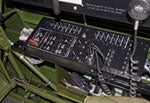 |
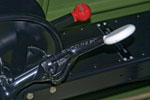 |
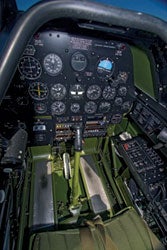 |
| The military airplane has a huge tandem-seat cockpit with placards, switches and levers that have been restored to their original condition. |
Between Smith and Greene, the finished product is about as original as it was possible to make. The result is a proven winner that has earned praise and awards everywhere Greene displays the airplane. Greene lives right down the road from Oshkosh, so it's only fair that he has won practically every warbird competition he has entered. Starting in 2001, Greene has taken home Grand Champion and Silver or Golden Wrench awards at Oshkosh, Sun 'n Fun and even the Dayton Air Show. The A&P flies his airplane about 50 hours a year during the air show season.
To fly the product of such love and dedication (not to mention money) is an experience somewhere between wonderful and terrifying. The machine looks and flies far better than any stock T-6 created by North American, but don't even think about what would happen if you broke it.
From the minute you step up to a T-6, there's no question you're dealing with a pure military airplane. There's not a vestige of anything civilian about the design. It's functional all the way, built with strength and utility as its primary goals rather than comfort or speed.
You'll note that efficiency wasn't mentioned above. It's not part of the airplane's mission, and the T-6 makes no attempt to accommodate for economy of size or operation. It's a big, barrel-chested airplane, a massive machine by general aviation standards, nearly 12 feet tall with a wingspan of 42 feet. In the civilian world, a Cessna 421 has about the same dimensions.
Out on the nose, there's a huge Pratt & Whitney R-1340 Wasp engine, a nine-cylinder radial rated for 550 hp (upgraded versions put out 600 hp), that's happy to haul the T-6's 5,600-odd pounds through the sky. This was P&W's first engine, and though it was a product of the 1920s, it was as reliable for its time as the famous P&W PT6A turboprop mill is today.
The engine was used singly or in pairs (or even in threes) in such military and civilian airplanes as the P-26 Peashooter, Boeing F4B, de Havilland Otter, Grumman Ag Cat, Lockheed Electra, Sikorsky S-38 flying amphib, Ford Tri-Motor and even the Gee Bee R-1 racer. The engine sports a whopping 1,344 cubic inches to pump out only 600 hp, so it's dramatically underworked in this application. (In contrast, a typical big-bore Lycoming 540 may deliver as much as 350 hp.)
Military engines pay little heed to fuel burn---your tax dollars at work---and the R-1340 is suitably overpaid. According to Greene, fuel burn at normal cruise runs about 32 gph, substantial but only half the P-51's rate of a gallon per minute (60 gallons an hour). At today's prices, you could expect to pay roughly $150 per hour for fuel on a T-6 at cruise. Throw in a little acro, and you could be pushing $200 per hour.
The tandem cockpits of the T-6 trainer are reminiscent of the airplanes they're intended to train for, especially if the final product is another North American model. Back in the '40s, the T-6 trained aviators for everything from P-40s and P-47s to P-51s and P-63s, so the cockpit was generic of military airplanes.
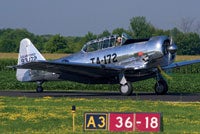 |
| This restored Texan is one of just 350 T-6s still flying; less than 16,000 of the advanced trainers were built in the '40s and early ’50s. |
By the standards of some fighters, the Texan's cockpit is huge, easily large enough to accommodate a six-foot-six-inch pilot. There are switches and levers virtually everywhere, and Greene's airplane reflects an accurate example of the original. Placards are mounted on practically every flat space, and they warn of everything from excess manifold pressure to proper use of the pilot relief tube.
Pilot and passenger sit tall in the Texan. You can easily rest your arm on the side rails abeam your rib cage. Visibility is good, provided you don't mind staring around the "birdcage" canopy structure. The view out front, past the large radial engine, is essentially nonexistent until you're in flight.
Engine start with any radial is always fun as all those cylinders slowly vote on whether to run. The engine typically comes to life one cylinder at a time, chug-a-putting smoke and oil and churning to full contentment over 20 to 30 seconds. Starting a T-6 is often an event at most airports, sometimes even gathering a small collection of Cessna and Piper pilots who marvel at the wonder of radials.
Taxiing is no particular challenge as long as you keep it slow and stay close to the brakes. Despite the T-6's large size, it has a deserved reputation as something of a squirrel on the ground. S-turns are the rule with alternate looks out the left and right sides of the airplane to see what you're about to hit. The airplane isn't a pilot-eater, but you fly it from chocks to chocks, and it will keep your adrenalin pumping most of the time, especially in any significant crosswind.
Takeoff is similarly exciting, mostly because of the decibel count. The Texan sports a huge Hamilton Standard propeller, and at full power, the tips race up near the Mach, creating that flat, blatting sound so characteristic of T-6s. The airplane is remarkably unapologetic for its noise level, and any pilot who doesn't appreciate it should perhaps consider taking up knitting.
This is a warbird, after all, but if you're expecting great things during climb, you'll probably be disappointed, despite the huge 254-square-foot wing. With power back to 32/2,000, the airplane will usually levitate at 1,000 fpm, little more than you'd expect in a Bonanza or Mooney.
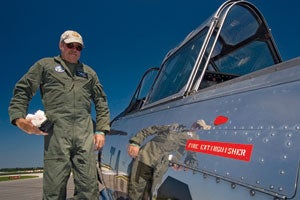 |
| Bill Greene's Texan has won practically every warbird competition it has entered, including Grand Champion at EAA AirVenture. |
In contrast, the Texan's in-flight manners are nothing less than wonderful. Acro is more fun than dogsledding. The airplane performs seemingly effortless rolls and loops, and it manifests the typical military behavior of being on the edge of a high-speed stall most of the time. Vertical reverses (where you roll to knife edge, push top rudder and pull) are loads of fun, with the airplane swapping wings from hard left to hard right in about two seconds.
Speeds aren't that impressive in any mode, cruise or aerobatics, but so what? Fellow contributor Budd Davisson, a warbird expert and acknowledged Texan lover, once wrote of the T-6, "The Texan is hardcore military, and the only difference between a Six and a fighter is [that] the number on the airspeed gauge is much lower. Numbers are only numbers. If you don't have telephone poles whizzing past to give numbers some scale, they're totally abstract, so you can play fighter pilot to your heart's content in a Six."
Cruise numbers in a T-6 (for those strange folks who waste time cruising in this airplane) are about the same as in a Piper Arrow---140 knots---and standard tanks (110 gallons) last for a little under three hours plus reserve. Stall characteristics aren't necessarily that much of a challenge, as long as you've had a proper checkout, have plenty of altitude and have an appreciation for the airplane's peculiarities.
"Because of the off-center alignment of the tail, you do get a little aerodynamic warning in high-speed stalls to the left," says Greene, "but practically none to the right. If you get too slow, and the airplane breaks right, it may go over onto its back, and you'll probably need two full turns to recover. That's one reason the catchphrase among T-6 pilots has always been ’No low, slow and pull.' Stall characteristics could be hazardous to your health if you haven't been properly trained---that's the key. Once you have the feel of the airplane, the Texan's stall is highly predictable. It's just not necessarily gentle."
Granted such tutelage, landings aren't necessarily any great challenge as long as you accept that they're not as easy as you think. Wheel or three-point "kerplunk" efforts work equally well. Just stay close to the brakes.
If you have a yen for a T-6 (and who doesn't), there's a limited supply available. The type was exported to some 34 countries, many of which maintained it as a trainer until a few years ago. Accordingly, the supply is sometimes aided and abetted by brokers who buy out those foreign air force inventories and return the airplanes to the United States.
Expect to pay $100,000 and up for a flyable airplane, mostly "and up." There's no telling what a gem such as Bill Greene's might sell for. For better or worse, however, that's not a problem, as Greene's prizewinner isn't for sale.

Subscribe to Our Newsletter
Get the latest Plane & Pilot Magazine stories delivered directly to your inbox






